Chef Mike stood behind an array of knives as he introduced us to the low rock, high rock and mince. A professor in a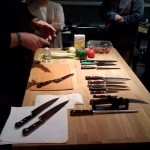 chef’s jacket, he taught the class how to hold, use, and care for knives while keeping safety in mind.
chef’s jacket, he taught the class how to hold, use, and care for knives while keeping safety in mind.
We were at the Wüsthof factory store on Wilson Avenue in Norwalk for an evening class on knife basics. Each of the dozen students had a work station set up with three knives and an assortment of vegetables ready to be chopped, sliced, or minced. It’s a genuine factory store, the only Wüsthof outlet in the U.S., with great prices and a vast selection.
Chef Michael Garaghty, Wüsthof’s Executive Chef and knife ambassador, came up through the culinary ranks: line cook, sous chef, executive chef, catering company owner, and is now the point man for knife training at Wüsthof-Trident of America. He’s the guy you would want in the kitchen for a special night out, a holiday dinner, or your daughter’s wedding; confident, competent, knowledgeable, and unflappable – a foodservice pro.
 Mike is a natural teacher who took us through the basics of knife manufacturing, knife design, and, most importantly, knife skills. As you may know, knives are the fundamental tools of the culinary world.
Mike is a natural teacher who took us through the basics of knife manufacturing, knife design, and, most importantly, knife skills. As you may know, knives are the fundamental tools of the culinary world.
Knives are manufactured two ways, stamped or forged. Stamped knives are inexpensive, serviceable and useful entry-level tools. You can spot them by their uniform thickness along the entire length of the knife – no sculptured bolster or finger guard. Forged knives are made from a single blank of high-carbon no-stain steel: heavier, balanced for comfort, durable, and able to hold their edge. Forged knives are not cheap, but they are indispensable lifetime tools for serious cooks.
Wüsthof makes hundreds of different knives, most intended for a specific purpose, but Chef Mike introduced us to three of the basics, useful to all cooks and fine for most kitchen jobs. The cook’s knife (also known as the french or chef’s knife) and its Asian cousin the Santoku are the most valuable. Both have a curved blade so you can rock the knife across the cutting surface. The cook’s has a more pronounced curve, the Santoku has a gentler curve and indentations perpendicular to the blade to help the food release as it is cut. Either style comes in a range of lengths from 6 to 12 inches. An 8 inch model is probably the most handy all-round and the best place to start a knife collection.
Chef Mike showed us the pinch grip for holding the knife: pinch the blade with your thumb and forefinger just in front of the bolster, and grip the handle with your remaining fingers. I found this a bit awkward, but could see that holding at the balance point like this gives the best cutting control. I’ve been practicing ever since.
There was a good deal of discussion about safety. Keeping the knife in contact with the cutting board is the best way to maintain control and prevent slips. For long foods like celery or carrots, keep your hand well back and move the knife towards it as you cut. For close-in cutting, curl your three middle fingers with the center one furthest out, so the blade of the knife can slide up and down the middle joint. Walk your hand back along the food with your thumb and pinkie as support. It takes a little practice.
Rock the knife forward and down to cut. Don’t lift the blade every time you take a stroke. The sliding motion of the knife across the food does the cutting. Don’t just push down. In this low rock technique, the knife slides back and forth across the food, the tip always on the cutting board, the heel of the knife lifting over the food on the pull stroke and pushing down and across on the cutting stroke.
The high rock is essentially the same, but the food is too big to permit full time contact with the cutting board. Think about cutting a whole onion. Hold the knife at an angle to the cutting board, point down and heel up, and push across the onion until the knife tip reaches the board, then, while still sliding the knife forward, continue the cut. It’s the same as the low cut, but for bigger food.
For mincing, say a handful of parsley, use the pinch grip at the handle and put three fingers of your other hand on the top of the knife near the tip. Imagine the cutting board is a clock and position the knife handle at 5:00 and with a few rocking cuts move the handle up to 3:00. Turn the pile of parsley and repeat the process. It’s surprising how quickly the parsley is reduced to a mound of evenly minced herb to add to your cooking.
Hard to understand these descriptions? Better take the class!
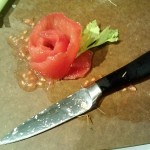 Mike also demonstrated paring knife technique. This small, handy workhorse of the kitchen is indispensable for close work. He discussed the uses of a utility knife, smaller than the cook’s model but bigger than the paring knife, with a narrower blade and only a slight curve, handy for in-between tasks.
Mike also demonstrated paring knife technique. This small, handy workhorse of the kitchen is indispensable for close work. He discussed the uses of a utility knife, smaller than the cook’s model but bigger than the paring knife, with a narrower blade and only a slight curve, handy for in-between tasks.
The cutting part of the class completed, (I’m happy to say no bandaids were needed) Mike showed his stuff by 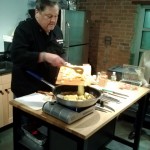 trimming and cutting a pineapple. While telling stories of knife fact and folklore from his kitchen career, he whipped up a caramelized Pineapple Foster (complete with flambé) and served it over pound cake.
trimming and cutting a pineapple. While telling stories of knife fact and folklore from his kitchen career, he whipped up a caramelized Pineapple Foster (complete with flambé) and served it over pound cake.
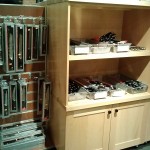 After class there was time for discount shopping in the Wüsthof factory store (333 Wilson Ave.) – a candy store of delights (and bargains) for cooks. Sharpen up your knife skills at a Wüsthof class. Future class dates are April 15, May 20 and August 19. For details, contact store manager Andrea (203-295-0601).
After class there was time for discount shopping in the Wüsthof factory store (333 Wilson Ave.) – a candy store of delights (and bargains) for cooks. Sharpen up your knife skills at a Wüsthof class. Future class dates are April 15, May 20 and August 19. For details, contact store manager Andrea (203-295-0601).







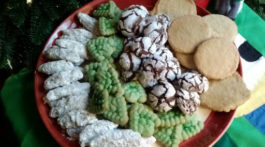

No Comment